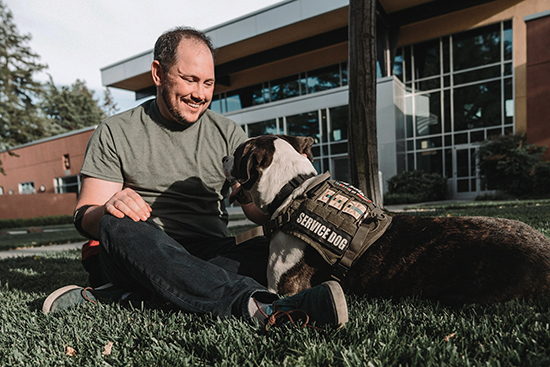Supporting veterans when they return home
(Family Features) Service dogs offer countless benefits to help combat symptoms of post-traumatic stress disorder (PTSD), but they can also be instrumental in rebuilding and uniting families after veterans come home from serving their country.
According to the National Institutes of Health, up to 30% of American military veterans experience PTSD after returning home from combat. Yet only about 40% of those individuals ever seek help.
Service animals are recognized under the Americans with Disabilities Act. The designation is limited to dogs who are trained to do work or perform tasks for a person with a disability. In some cases, these tasks are highly physical in nature, such as guiding a person who is blind or pulling a wheelchair. Other roles service dogs play may be less immediately visible, such as providing a calming presence to a person with PTSD who is experiencing an anxiety attack.
More Than a Companion
Service dogs are highly trained to assist military veterans in achieving better quality of life. Veterans who utilize service dogs report lower levels of depression and anxiety, fewer hospitalizations and a reduction in medical and psychiatric costs, among other benefits. Beyond what these canines help prevent, consider these examples of what they empower:
- Ease loneliness and stress
- Reduce social anxiety
- Decrease reliance on prescription drugs
- Help veterans return to work or attend college
- Strengthen personal relationships
- Provide security, protection and unconditional love
Up to the Task
Just like the members of the armed forces they help, service dogs are highly trained professionals with an important job to do, including tasks such as these:
- Turn on lights and open doors before a veteran enters his or her home
- Nudging, pawing or licking to interrupt flashbacks or nightmares
- Utilizing body weight as a grounding mechanism to reduce anxiety or alleviate panic
- Retrieve bags with medications or a list of numbers to call during a medical emergency
- Provide security and reduce hypervigilance in public places
- Pick up dropped items and assist with mobility and ambulation
When You See a Service Dog

Service dogs are often large breeds that stand out in a crowd, and their calm demeanor can make it seem perfectly appropriate to approach and pet them. However, it’s important to remember that service dogs are at work and distractions can prevent them from providing the service their owners need.
The International Association of Canine Professionals offers these etiquette tips for interacting with service dogs and their owners:
- Remember that a service dog is there as support for a person with a physical or health disability, which may or may not be readily apparent.
- Respect that health conditions are private matters most people prefer not to discuss with strangers.
- Just as you would not stare or point at a person in a wheelchair, avoid calling unnecessary attention to a person with a service dog.
- If you must interact, always focus your attention on the handler, not the dog, so the dog can stay focused on its job. Avoid whistling, clapping or otherwise distracting the dog.
- Teach children not to approach service dogs. Although most are trained to avoid aggression, a perceived threat to their handlers could result in warning growls or barks that may scare a child.
To see video stories of how service dogs have impacted the lives of veterans and their families, visit DogChow.com/service. In addition, for every purchase of specially marked bags of Dog Chow Complete Adult through Nov. 1, the brand will donate 5 cents, up to $100,000, to the Tony La Russa Animal Rescue Foundation Pets and Vets program, which matches veterans experiencing PTSD and other challenges with service dogs, free of charge.







